LESSON 6: MAGIC AND THE SCIENCE OF MEDICINE
I have given you in previous lessons some of the History of Magic and Magic's Relation to Religion. Now I shall trace for you Magic's relation to the great science of Medicine.
The Art of Medicine today with its profound studies of human ills is a far cry from the elementary medicine practiced by Magicians of old and still practiced by barbaric tribes. Yet this great and highly developed art had its origin in the crude practices of ancient magicians.
Origin of the Art of Healing
The most primitive method of treating disease was the use of spells and incantations by the magician. Then came the use of stones, sticks, and strings to draw out diseases. And later began the use of some practical remedies in combination with magical remedies. Essences and elixirs and ointments made from herbs and barks were administered by the magician. But with these remedies were still required the magical formulae which dealt with the demon-cause of the ailment. These herbs, though many are now used by Pharmaceutical and Medical Science, in ancient times were chosen for magical rather than for medicinal reasons.
Inseparably Bound Up With Magic
Among the Chinese, the head of a plant was used to cure the head of the patient, the middle of the plant was used to cure the body of the patient, and the roots were used to cure the patient's legs. In the same way European doctors practiced what is known as "doctrines of signatures." This was, in fact, mere magic. They prescribed "eye-bright," a flower with the likeness of an eye in it, for complaints of the eyes. They treated small-pox with mulberries because their color made them proper for diseases of the blood. Thus magic and medicine were equally important in the infancy of the treatment of disease. These magical practices clung to the Science of Medicine just as Magic maintained its strong hold on Religion.
Magic Influence of Planets
A definite system of relationship between the planets and medical art was devised by the ancients and this system was one of the main foundation stones in the development of the Art of Medicine. The influence of this system was apparent up to modern times, and in many foreign lands it still holds sway to some extent. By this system the human body was divided into sections which were under the power of certain planets.
Each planet was designated as capable of causing or curing certain diseases. These beliefs, of course, began with the art of divination and then became amalgamated with the primitive art of healing.
A table was worked out in which was stated the plants and herbs that were connected with each planet and the hour during which these should be prepared. The time which was auspicious for administering medicines and for performing operations was also recorded. Thus the "doctor" or sorcerer could consult his table and therein find the treatment for his patient. If the results of the treatment were harmful or even fatal, the sorcerer was absolved from blame because the people believed that the planets were at fault, not the doctor. Even in more modern times, in the 17th and 18th centuries, a doctor might lose case after case and yet he was not condemned for it was believed, not that he did not know his art, but that the planets were inauspicious.
Methods of Earliest Doctors
This is the system of diagnosis and treatment used by the sorcerers, who were the first doctors. When a man became ill, the first thing to do was to discover the nature of his disease by means of the planets. If the moon was in a certain relation to Saturn at the time, for instance, it indicated that the man had a headache and cough. This was the diagnosis. Then the herbs which would be effective under these conditions of the moon and Saturn and the ailment of the man were studied. With this determined, the hour at which the medicine must be administered was found according to the planetary system. And thus the treatment of the ailment was arrived at. So we see that the art of the earliest doctors was much magic and a little medicine.
Mystic Charms and Signs Used
Talismans and charms with pictures and insignia of the planets on them were used also by the sorcerers in addition to the herbs and plants and minerals which the planets governed. Mystic characters and signs were an inseparable part of early medical practices. A circle was believed to have great influence in curing disease. The origin of this seems to have been in primitive sun worship. Certain numbers had great significance also in effecting cures. A combination of the numbers and signs sometimes was the whole treatment for some diseases. Consumption, for instance, was treated by passing the patient through a circular wreath of woodbine three times. This woodbine had to be cut during the increase of the March moon.
Some sorcerers cured their patients in this manner: They took a garland of green woodbine and caused the patient to pass through it three times. The garland was then cut into nine pieces and cast into the fire. This was a sure cure. Whooping cough was believed to be cured by giving the patient a certain draught to drink from the horn of a living ox, nine times repeated. All draughts and ointments, of course, had to be prepared according to the hour when certain planets were ruling.
These magical practices in connection with the Art of Healing were used for centuries up to modern times. With the enlightenment of the ages, medicine has been gradually releasing itself little by little from the influence of magic.
Magic a Great Aid in Business
I have told you how Magic will develop your personality socially. The importance of personality in the social world is great because being well known and well liked means so much in your happiness. Think, however, of the tremendous significance of personality in business. You know that it's the man with personality who gets ahead every time.
You Make Lasting Impression
As Magic develops your personality you find that you are progressing in your business. With the training in Magic which you have, you are better able to meet people. You have a little trick with which to break the ice when you call on a customer. In this way you can get the interest and attention of the man you are after. And you leave with him a lasting impression for he will remember you as the man who is clever at tricks. This business man becomes your friend because you arouse his interest in you as a personality. Your Magic has helped you win this man as a business friend and through him you meet other men either in a business or a social way. However, magic, like everything else, has its proper place and should be used with intelligence.
Invaluable to Traveling Salesmen
Magic has been proved to be invaluable to traveling salesmen. If he knows the Mystery of the Burning Cigarette, for instance, he has right there in that trick a powerful means of getting the prospective customer's interest. He calls on his man and starts talking business. At a proper moment he asks the man to loan him his lighted cigarette as seeing the man smoke reminds him of a little trick which he would like to show him. He performs this wonderfully puzzling little trick and he has his prospect smiling and good natured and interested. Then when he gets back to business, he has the good will of his prospect and can very probably make the sale.
I have heard that one of the salesmen for Maytag Washing Machines is using Magic to aid him in his sales with remarkable results.
Magic a Wonderful Hobby
If you aim to go on the stage or if you plan to become a semi-professional magician to make money on the side, you will have to study and practice principles and fundamentals and moves and tricks for a while yet before you will be proficient and will have a wide enough repertoire to accomplish your aim.
All of you, however—those who have ambitions of making money with their magic, those who want magic to bring them social popularity, and those who want magic to help them in their business—can start now with Magic as your Hobby. I am sure you realize by now what a wonderful means for relaxation from your daily work you have in Magic and what a fascinating additional interest in life you gain in studying the art.
Men in every field of business and professions—doctors, lawyers, salesmen, artists, men in every kind of business-- have taken up Magic as a Hobby and found rich rewards in having a fascinating and distinctive art.
LESSON 6
In this lesson we study cut and restored cord effects. I give you THREE good methods for this part of Magic. I could give you just one way of getting these effects, but let me say again, I want you to be prepared for emergencies so that when it is not convenient to use one method, you may use another. Remember that what I am training you in is the foundation of magic—the underlying principles. From these principles I hope that some day you will build original combinations and make a name for yourself through your Individuality. First, however, you must be well grounded. I cannot teach you your individuality--that you must develop for yourself—but I do want to give you tools to work with.
1. KELLAR'S CUT AND RESTORED CORD
Harry Kellar was a great magician. He ranked among the world's best. A masterpiece in his hands was a cut and restored cord trick that baffled even magicians. Kellar died some time ago, but his cord effect lives on. I give it to you here.
EFFECT:
A piece of wrapping cord about 30 inches long is shown and cut in half by a member of the audience. Performer holds the two pieces far apart to show that the cord has been actually cut into two pieces. Magician then takes two ends, ties them together, and in a moment the cord is restored into one piece again.
PARAPHERNALIA:
1--A piece of ordinary tightly wound wrapping cord, a sample of which we sent you with your box of apparatus. This cord may be purchased at any hardware or department store.
2--A piece of magician's wax, a box of which we have also sent you.
3--A pair of sharp scissors. I usually carry a pair of blunt end scissors in my pocket.
SECRET AND PATTER:
To Prepare:
Take the piece of cord. With a sharp knife or scissors taper the ends of the cord off into a point. Now take a little of the wax out of the box with your finger nail, and wax ends well. To see whether you have done this properly, take the two ends and hold them together. Roll them and press them until they stick together and string looks like one piece. If this has been done right, the keenest eye at a short distance away cannot see where the joining was made. Pull ends apart, smooth them down to a perfect taper on each one, and you are ready to perform.
Like many other GOOD effects, this one has a SIMPLE modus operandi.
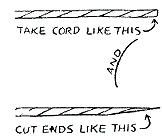
Show cord freely. Take scissors and hand them to a spectator.
"For this experiment I want to show you a masterpiece formerly performed by a great magician—Harry Kellar. Kellar, as you no doubt all know, was one of
the greatest magicians of his time. Some people say that Kellar got the idea for this experiment when he saw a Hindu magician, sitting in the street somewhere in India and performing to a crowd of tourists, do mysterious and bewildering things with a piece of string. But however that was, I have been very lucky to obtain Kellar's great effect and now take pleasure in showing it to you." Hold cord up between your hands.
"Kellar used just an ordinary piece of wrapping cord such as I have here. Sometimes he would just cut a piece of cord from a package at hand. Now, sir, will you please take the scissors and cut this cord through the middle?"
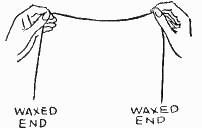
Spectator cuts cord in half. Bring your hands farther apart to show that cord was cut.
"You are quite certain, sir, that you cut the cord in two and that it is now in two pieces?"
Turn to audience, and as you do so, reverse cords so that waxed ends, which have before been hanging down, are now at the top.
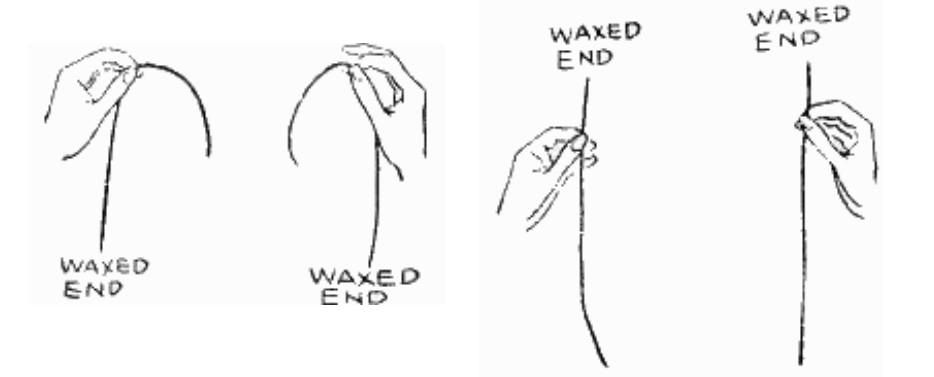
"And you are also quite certain, are you, that the cord has been cut in two? All right then, watch."
Bring the two waxed ends together, overlap them, and hold both ends between thumb and first and second fingers of left hand.
Press waxed ends together and roll them a little between fingers and thumb of left hand so as to make the joining the same diameter as the rest of the cord.
While doing this, to help distract attention from the left hand, take End A of cord, loop it through near middle of cord.
Pull End A through and tie a single loop knot in cord.
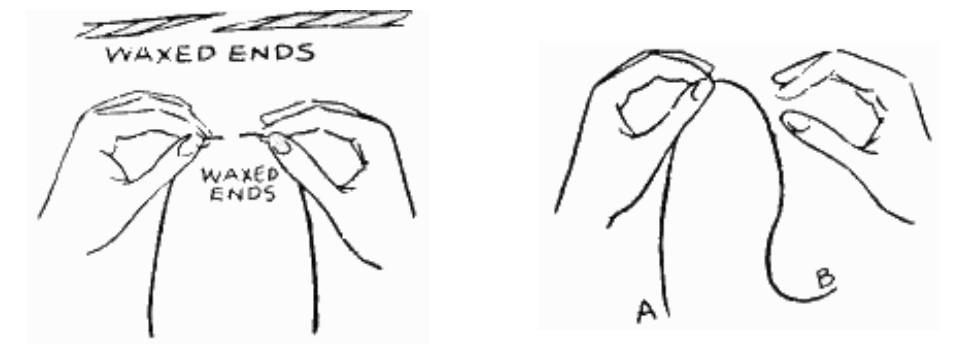
"Kellar would take an end of the cord, bring it up and pass it under and through this way to make a loop. Then he would take the end and push it through the loop again with the result that the knot became untied." Take End A with right hand and push it back through the loop. This, of course, unties the knot.
Hold End A up with right hand as shown in illustration.
"This movement, of course, caused the cord to come back again into one piece."
Drop cord from left hand and let it hang from right hand. Show palms freely as well as restored cord. It looks as though the cord were actually restored if the joining has been done properly, and it will fool the closest watchers.
"And there it is just as good as new and ready to tie a package with again."

Roll cord up loosely and place in pocket. Sometimes I have a duplicate cord in my pocket. As I put my hand in my pocket to leave cord, I exchange cords. Then I bring out the new cord to start a new trick with, such as the ring off the string, etc. The audience thinks I use the same cord which I had just restored. Or sometimes I take the whole cord out of my pocket later and toss it carelessly away, where some inquisitive one is sure to find it later. When he finds an ordinary piece of cord undamaged in any way, he is thoroughly puzzled.
2. COMEDY VERSION OF GERMAINE CORD EFFECT
EFFECT:
This is a popular method of Karl Germaine's and is similar to the Kellar effect except that cord is tied together at first to form a loop. Center of looped string is cut, tied together and restored in a mysterious manner. To Prepare:
Take a piece of cord as in the first effect. Taper the ends and wax them. Then bring these ends together and press and roll them together until they make an unnoticeable joining. You now have a loop of string.
Now take a piece of same kind of cord about 5 or 6 inches long. Pinch large loop of cord at point B so that
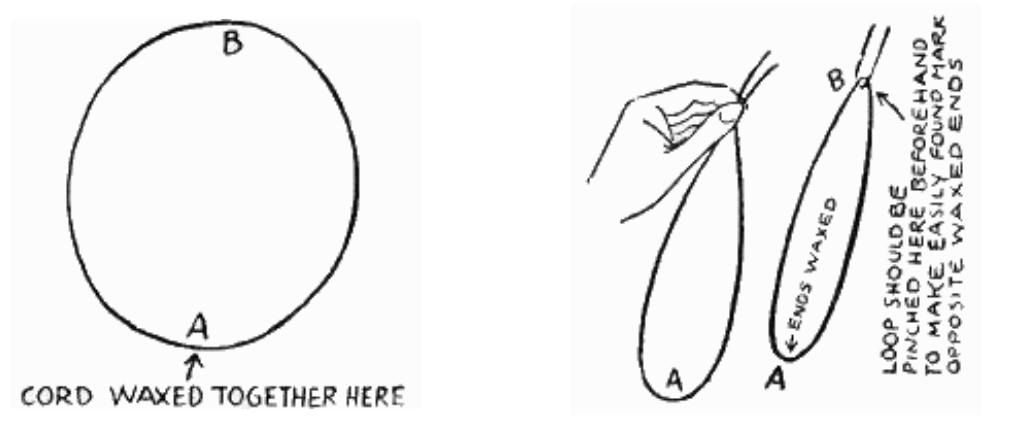
you can easily find point opposite from waxed ends. At point B loop this small piece of cord through large loop. When loop and small cord are held together with thumb and fingers, the effect is that of a piece of cord with cut ends sticking up from between fingers. This arranged loop with small cord may be placed behind some object in readiness for the trick. Get it and hold in left hand as shown in illustration.
SECRET AND PATTER:
"Is there anyone here who understands the ecclesiastics of geometry? No one? Are you sure? If so, then I shall explain it with confidence. To begin with we have to have a circle. Has anyone a circle in his pocket? No? Such being the case, I will make a circle by tying the two ends of this cord together."
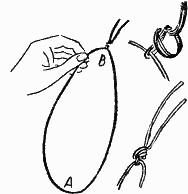
Tie ends of cord together. Illustration shows easiest way to do this. This method will prove very useful later on in the course also.
After ends are tied, show loop to audience. To them it looks as though you had made a loop from an ordinary piece of cord.
"Here's our circle."
Hold up cord with fingers and try to make it circular in shape.
"Not such a good circle, but that is because of the hole we built it around. Of course, you understand that a circle is merely a straight line built around a round hole, and then the ears are chopped off." Point to ends of cord to show ears.
"Anyway that's my story and I'm going to stick to it." Pick up scissors.
"I cut a hole in the circle."
Hold up cord and cut through the place WHERE ENDS WERE WAXED TOGETHER. One end, of course, falls downward.
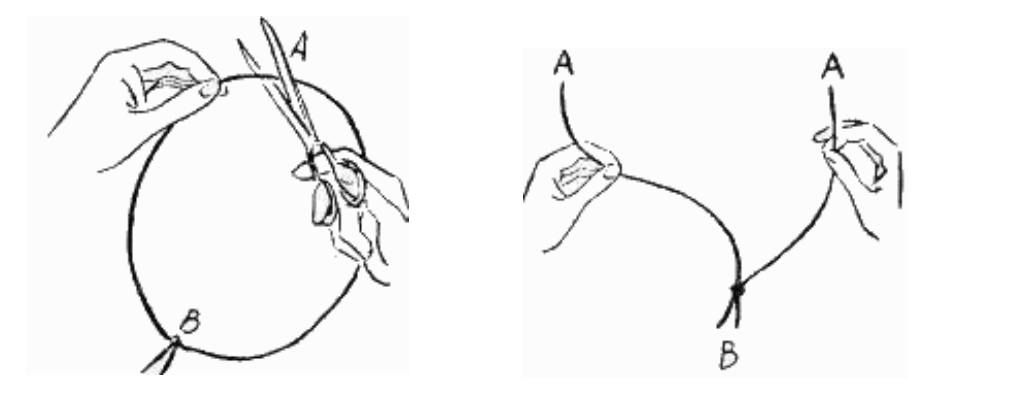
"And behold, the circle has gone."
Bring both ends together, but hold one about half an inch higher than the other.
"Just look, how uneven I cut those ends!"
Trim off upper end a little, then lower end a little, and then cut both ends even.
To the audience this looks like by-play, but to you it means destroying evidence. You are cutting the waxed telltale ends away.
Hold ends about a foot apart. "There, they look a lot evener now." Pull cord out straight.
"We have a straight line again—that is, it would be straight if it wasn't for those ears."
Nod your head to knot in center of cord. "Now, we'll tie the ends together again." Tie ends together.
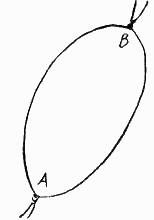
"And there we have a circle again."
Show loop with knot on each side.
"That is, it would be a circle if it were! round and if it weren't for the ears. We now have two pairs of them."
Hold the loop as shown in illustration (next page). It gives a rabbit-like effect.
"Ah—there's a rabbit—body, head, and ears. I shall now show you the vanishing rabbit." Let cord fall back into original large loop again.
"I think I'll cut the ears off."
Pick up scissors. Hold End B of cord, as shown, in left hand. This is the end with the short piece of cord tied around it. Cut the knot off. This does away with the short piece of cord. You may, if you desire, cut the ends two or three times before cutting the knot off. Start with the ends and work toward the knot.
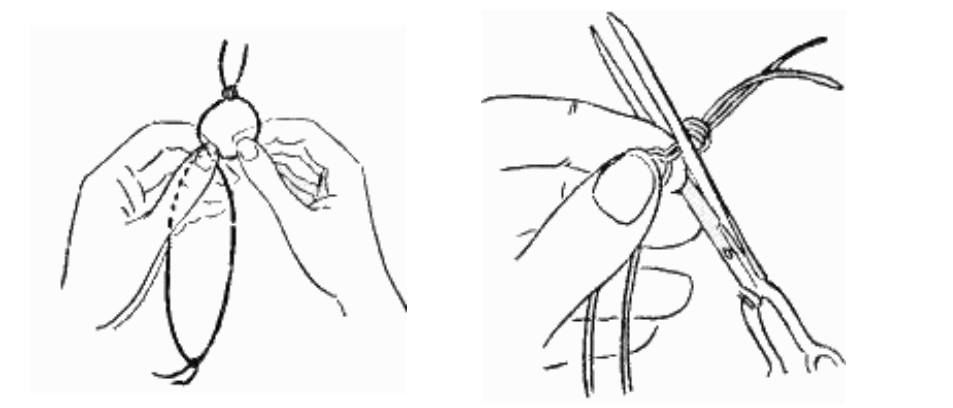
Hold cord together in left fingers so that it looks as though you are holding two ends. The audience thinks that cord is cut and that two ends are covered by your finger tips.
"That's a good idea, only when you cut the ears off you still have two ends left, and we are just where we were before with our straight line. If I tie the ends together, we have ears again. But ah-ha—I have an idea."
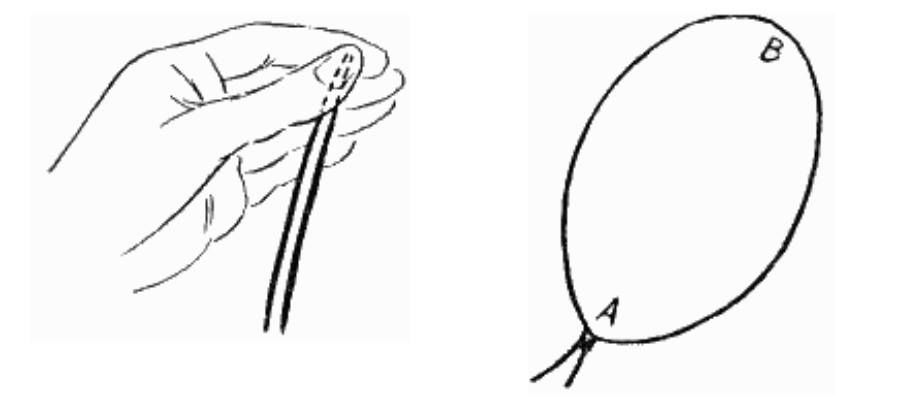
Point at knot hanging downward.
"The knot is made up of two ends—this makes the other two ends in the middle. Well—well, why didn't I think of that before? That changes everything all around. With the two ends in the middle, I have but to say, 'Papa loves mama, mama loves papa,' and unite them as one." Open up loop and show that cord is united. "And they lived happy or unhappy ever after." Hold up loop to look like a circle.
"Which, of course, brings us back to the problem of the circle. But why worry about a circle? We unknot the knot here. This gives us two ends, so we pull the string out into a straight line, and there I have proved that a straight line is the nearest distance between two ends."
Hold cord out by its ends so that it is pulled taut. Show palms empty while holding cord. Then give cord to a spectator.
"There sir (or madam, or miss), take this cord home and work on your lesson for tomorrow."
3. AN IMPROMPTU CUT AND RESTORED CORD EFFECT
This method of doing the cut and restored cord effect is commoner than the two methods which I have already given you. The reason for this is that this method requires no preparation. It can be done anywhere at a moment's notice. You can use this method on occasions when you cannot prepare your cord and have to work with what you have at hand.
EFFECT:
Spectator cuts a piece of string or cord, held by Magician, through the center with a knife or pair of scissors. Magician then ties ends into a knot. In a moment string is shown to be completely restored.
PARAPHERNALIA:
1--A piece of string or wrapping cord about 30 inches long.
2--Sharp knife or pair of scissors.
SECRET AND PATTER:
Show cord and hands freely.
Hold cord in both hands as shown in first illustration.
"I see by the papers that some inventor has brought forth a non-destructible wrapping cord. So much goods has been damaged because the string around packages breaks when express men throw the packages at each other. Something had to be done to prevent such losses. Let me show you how this newly-invented string works."
Bring end of string held in right hand around into position shown in second illustration.

Grasp it between tip of first finger and thumb of left hand. Turn hand around so that palm faces audience. Spread fingers so that audience can see how string is held.
"Cord usually breaks in the middle--very seldom at the ends, so we must find the middle, which must be about in the center."
Look at part B of cord, extending between hands. As you see above, let go of end A of cord and let it drop. Audience can plainly see now that B is the middle of the cord.
REPEAT PROCESS OF BRINGING END "A" UP in between finger and thumb of right hand. This repetition helps to convince spectators that the middle of the cord is really between your hands.
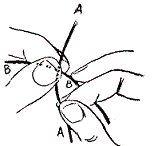
"There, that is good enough without measuring. Now, sir. if you will please take your pocket knife and cut the string through the middle . . . . ."
Or if you have a pair of scissors handy, ask spectator to use those. As you make the request, you make a movement that is very IMPORTANT in working the trick. Hold cord about six inches from you. Study illustration carefully.
Tip of first finger and thumb of right hand hold A. Second finger of right hand is used to push B downwards in front (towards audience), and A is brought upwards. In other words, just reverse the position of A and B. Note that while doing this, the fingers of both hands are close together.
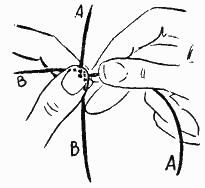
This movement leaves a twist in the cord between first finger and thumb of left hand. As soon as A and B are exchanged, move right hand along cord A to a distance about four inches away from left hand. Bring hands forward while doing this. To the audience it looks as though you had right hand near left and then as you brought cord forward, you merely slid right hand away from left.
Movement of bringing hands forward appears to the audience to be a gesture in asking spectators to cut cord.
"Now just cut the cord here at the middle, that's near enough."
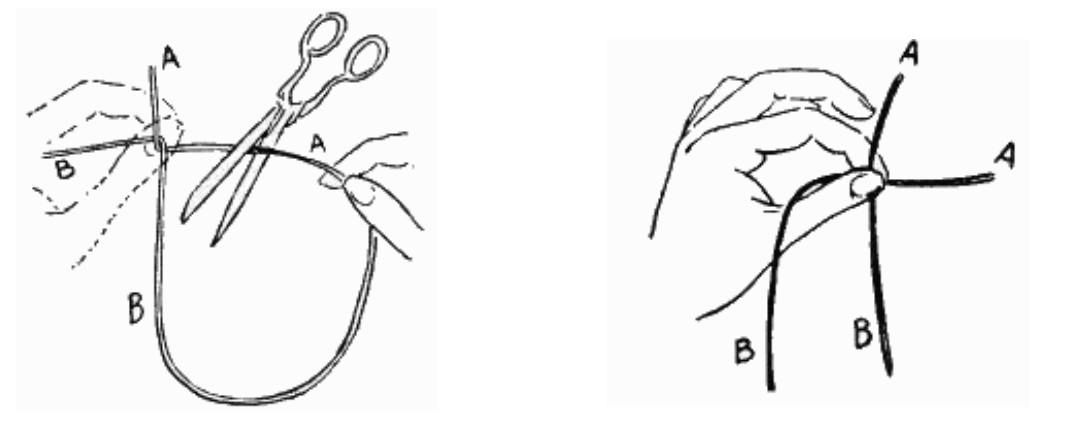
Spectator cuts cord. Allow cord held by right hand to drop. To audience it appears that cord has been cut in middle as two short ends extend upwards from fingers of left hand and the other two ends hang down.

The audience thinks that you have had cord cut in half, but in reality cord has been cut only four or five inches from the end. The ends extending above your left fingers are the ends of the short piece of cord which spectator has cut off for you. Tie a double knot with the ends AA.
"Please, sir, hold this end of the cord, and you, sir, please hold this end."
Give each end of cord to a spectator to hold. The knot is in the middle of the cord. Even to the closest observer it looks as though the cord had been actually cut and the ends tied together.
"I had the cord cut by the gentleman here to represent the cord around a package breaking. Now, expressmen do not always bother to tie up the cord again as I have done here— besides the cord may be too tight to allow tying."
Cover knot with right hand and close hand over it. Then place left hand over right hand. Slip knot along cord under right hand by moving hand towards the right. Left hand is closed around cord WHERE KNOT WAS. The effect is that you covered knot with right hand, then changed your mind and covered it with left hand. Address gentleman holding cord at right.
"Please, sir, take hold of the cord a little nearer the middle."
Your right hand keeps the cord from dropping as spectator lets go of it and then takes hold of it nearer the middle. This gives you an opportunity to slip knot off of cord under cover of your right hand. Let right hand fall to side for a moment after slipping knot off.
"Now, will both of you gentlemen please hold the cord tight, and I will take my handkerchief . . . . ."
Reach into right coat pocket with right hand and drop knot therein. Bring hand out suddenly and then reach into trousers' pocket and out again, as though you were looking for a handkerchief but couldn't find one.
"Never mind, I thought I had a handkerchief that I could cover the knot with. But I suppose the audience wants to see what happens anyway, and it is so much harder to see things when they are covered. However, to get back to this wonderful new indestructible cord. The point is that this cord, if it breaks while on a package,
will not stay broken but will automatically come together again. It will restore itself as good as new." Lift left hand from cord. Of course, the knot is gone as you placed it in your pocket.
"Pull the cord, gentlemen, and see whether it is not as strong as ever. Quite an invention, I assure you."
NOTE:
Another way of getting rid of small piece of string is simply to take string in hand and cut off piece by piece as you did in the Germaine version, until it is entirely gone.
After you tell your audience about expressmen not bothering to tie up the cord and that besides the cord may be too tight to allow tying, you may continue the patter in this way:
"So, if we cannot have a knot we must not. I'll cut off a piece for you and a piece for me. A great big piece for you and a little tiny piece for me and an extra souvenir for the lady over there." As you say the last sentence of the above, cut the knot from the cord.
"We have no knot, but we do have a couple of good ends left. After all, what's a couple of ends between friends when we have inventors. What I wanted to tell you about this new indestructible cord is that when the cord on a package breaks, it will not stay broken. Each end seeks out its mate, comes together with the other end and sticks stronger together than true lovers at first sight." Lift hand from cord.
"Pull the cord hard, gentlemen, and see whether it isn't just as strong as ever if not stronger. This shows the wonderful power behind inventions."
In performing this impromptu method of cutting and restoring a cord, you may do the trick with rope, string, or ribbon.
You may take a clothes line, for instance, unroll three or four yards of it, and perform the trick. Using a clothes line makes a good stage effect. Your patter could be based on a wash day experience.
Later on in the course, I will show you how this principle is applied to some pretty stage effects.
TARBELL SYSTEM, INCORPORATED, Chicago.
Bạn đang đọc truyện trên: truyentop.pro